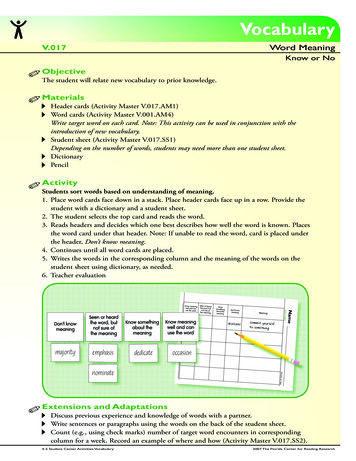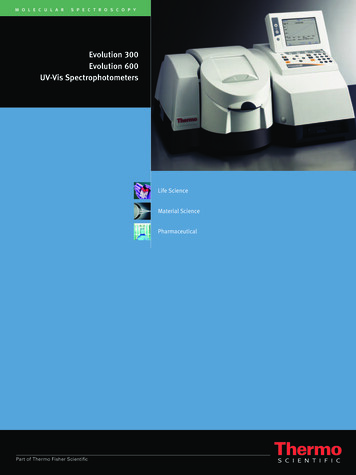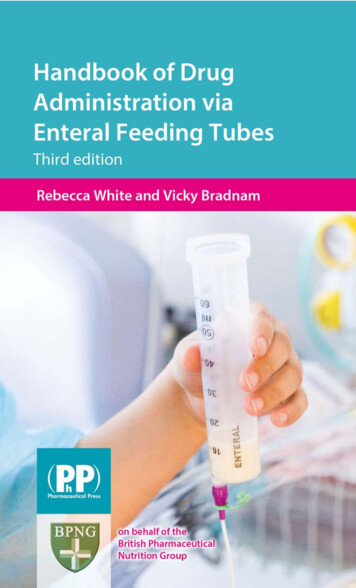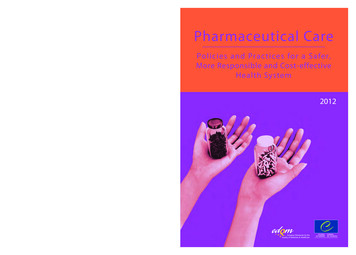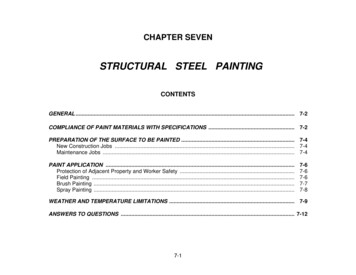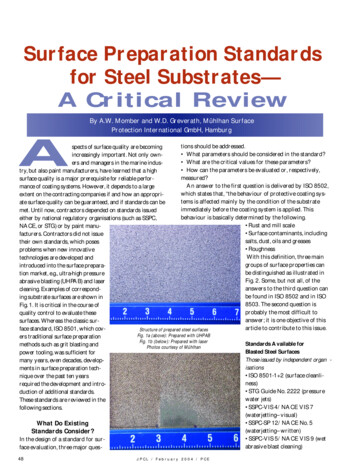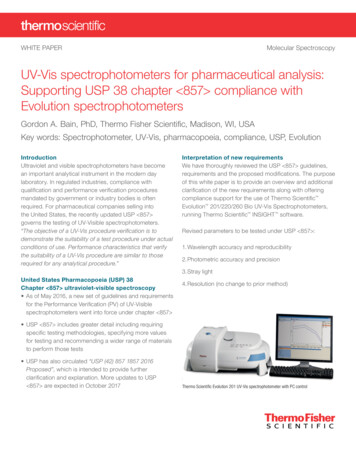
Transcription
WHITE PAPERMolecular SpectroscopyUV-Vis spectrophotometers for pharmaceutical analysis:Supporting USP 38 chapter 857 compliance withEvolution spectrophotometersGordon A. Bain, PhD, Thermo Fisher Scientific, Madison, WI, USAKey words: Spectrophotometer, UV-Vis, pharmacopoeia, compliance, USP, EvolutionIntroductionUltraviolet and visible spectrophotometers have becomean important analytical instrument in the modern daylaboratory. In regulated industries, compliance withqualification and performance verification proceduresmandated by government or industry bodies is oftenrequired. For pharmaceutical companies selling intothe United States, the recently updated USP 857 governs the testing of UV-Visible spectrophotometers.“The objective of a UV-Vis procedure verification is todemonstrate the suitability of a test procedure under actualconditions of use. Performance characteristics that verifythe suitability of a UV-Vis procedure are similar to thoserequired for any analytical procedure.”Interpretation of new requirementsWe have thoroughly reviewed the USP 857 guidelines,requirements and the proposed modifications. The purposeof this white paper is to provide an overview and additionalclarification of the new requirements along with offeringcompliance support for the use of Thermo Scientific Evolution 201/220/260 Bio UV-Vis Spectrophotometers,running Thermo Scientific INSIGHT software.Revised parameters to be tested under USP 857 :1. Wavelength accuracy and reproducibility2. Photometric accuracy and precision3. Stray lightUnited States Pharmacopoeia (USP) 38Chapter 857 ultraviolet-visible spectroscopy As of May 2016, a new set of guidelines and requirementsfor the Performance Verification (PV) of UV-Visiblespectrophotometers went into force under chapter 857 4. Resolution (no change to prior method) USP 857 includes greater detail including requiringspecific testing methodologies, specifying more valuesfor testing and recommending a wider range of materialsto perform those tests USP has also circulated “USP (42) 857 1857 2016Proposed”, which is intended to provide furtherclarification and explanation. More updates to USP 857 are expected in October 2017Thermo Scientific Evolution 201 UV-Vis spectrophotometer with PC control
Wavelength accuracy and reproducibilityUSP 857 requires that wavelength accuracy andprecision (reproducibility) be tested in the regions ofthe UV-Visible spectrum that are being used to analyzesamples with the instrument under test.Supporting compliance1. If samples are measured at wavelengths above 635 nm,performance verification with a didymium standard willbe required. If all sample measurements are performed at 635 nm there is no requirement to test with didymium.The exact text refers to “the intended operational range.”2. INSIGHT software versions 2.3e and higher perform allthe tests according to the new USP requirements.1. Peak positions must be reported as the mean ofsix measurements2. Accuracy in the region 200-400 nm must be 1 nmor better3. Accuracy in the region 400-900 nm must be 2 nmor betterNote: Those without a holmium wavelength standard andthose requiring didymium, may wish to use the calibratedholmium and didymium glass filters included in theThermo Scientific Validator package for INSIGHT software,offered for use with Evolution spectrophotometers. Pleaserefer to Appendix B for available solutions for wavelengthaccuracy and reproducibility testing.4. Precision at all wavelengths must be 0.5 nma. The “in-force” text requires that the standard deviationof the six measurements be 0.5 nmb. The “proposed” text requires that the maximumdeviation from the mean be 0.5 nm5. Wavelength accuracy of the instrument in the UV-Visiblerange shall be tested using either:a. Holmium oxidea in perchloric acid at specificwavelengthsb between 241.1 nm and 640.5 nmb. Atomic emission lines from Hg or D2 discharge lampsbetween 253.7 nm and 579.1 nm (Hg)c or at 486.0 and656.1 nm (D2)6. If samples are measured above 635 nm, wavelengthaccuracy at 730 nm and above must be tested usingdidymiumd solution.USP 857 allows the option to use glasses containingholmium or didymium rare earth metal oxides as anallowable alternative to solutions or atomic emission lines,stating “traceable CRMs are commercially available andcan be used.”aPhotometric accuracy and precisionUSP 857 requires the user to “verify the absorbanceaccuracy of a system over its intended operational range .for the wavelength and absorbance range required.” Inthe UV range, USP requires the use only of potassiumdichromate solutions in 0.001M perchloric acid anda photometric accuracy requirement of 0.010 A atabsorbance values below 1 A, and 1% of the certificateabsorbance value above 1 A. The “in-force” text also states“In the 0–200 mg/L range, potassium dichromate solutionsprovide reference values of up to 3 absorbance units at oneof the certified values of 235, 257, 313, or 350 nm.” In the“proposed” text, the USP committee states “The control ofabsorbance OQf must include at least one assessment ateach wavelength range in the 0–1 A region. If absorbance 1 A is to be used for quantitation, then control ofabsorbance must also be evaluated in the 1–3 A range.”It is important to note that while the text does state thatverification of absorbance accuracy over the intendedoperational range is required, it does not require testing ofabsorbance accuracy up to 3 A. It states only that solutionsfor performing this test are available. The clear intent isthat standards should be chosen in which the absorbancereflects the actual operational range of acceptable samplesin the laboratory.The use of holmium oxide in a glass matrix is also called out as acceptable. Note that the lowest wavelength calibrated peak in holmium glass generally occurs at 279.3 nm. If shorterwavelengths are to be used for sample measurements, a holmium solution (shortest wavelength peak at 241 nm) should be the preferred choice.bSee Appendix A for details on the test wavelengths called out for different reference materials.cThe in-force test states that “The lamp needs to be placed at the source position in the spectrophotometer.” This requirement means that the Hg lamp on the Evolution 200 seriesspectrophotometer does not comply with the strictest possible interpretation because it is positioned in the light path of the normal beam but not at the source position.dA mixture of praseodymium and neodymium.eVersion 2.2 of INSIGHT software introduced the new testing methodologies, but has been superseded by version 2.3, which offers the additional convenience of partial automation of the testing.fOperational Qualification
USP 857 also requires that photometric reproducibility(absorbance precision) be measured as follows: “Theabsorbance precision can be determined as the standarddeviation of at least six replicate measurements at two ormore absorbance levels over the operational range (Table 1).The standard deviation must not exceed 0.5% A (for valuesabove 1.0 A) or 0.005 A.”AbsorbancelevelsUV-Visiblerange 1 A200-400 nm 1 A400-800 nm 1 A430 nm*1 A to 3 A200-400 nm1 A to 3 A400-800 nmUSP 857 2015requirement60 mg/LpotassiumdichromatesolutionNeutral densityglass filterscalibrated forabsorbance atthe standard NISTwavelengths of440, 546.1, 590and 635 nm600 solutions atconcentrations ofup to 200 mg/LNeutral densityglass filterscalibrated forabsorbance atthe standard NISTwavelengths of440, 546.1, 590and 635 nmTable 1: “Proposed” updates to photometric accuracy and precision methods.*Also recommended by European PharmacopiaNote: A potassium dichromate solution providesphotometric data at four different absorbance levels at fourdifferent wavelengths. It may be sufficient to show thatabsorbance precision is maintained at the different levelsreported in the measurement of a single standard. This willmost likely be auditor-dependent, so some laboratoriesmay choose to own two different dichromate solutions.In the case of neutral density filters, it will be necessaryto test two different filters. Please refer to AppendexB for available solutions for wavelength accuracy andreproducibility testing.Stray lightOverview: USP 857 expands the number of solutionsthat can be used to test for the presence of stray lightcompared to what was required in the previous version. Italso introduces a new method for measuring stray light calledthe Mielenz Method. This method requires use of a 5 mm cellcontaining the same standard to be used in the referenceposition. While the Mielenz Method may result in a moreaccurate measurement of stray light, especially in instrumentswith a photomultiplier tube (PMT) detector, very low levelsof stray light, or a very limited measurement range, it is notnecessary when used with Evolution spectrophotometers.A direct measurement of the stray light using a 10 mm cellreferenced against deionized water will indicate whetherthe stray light level is below the required limit. This isrecognized within USP 857 which states “Alternatively,analysts can measure the absorbance of the filtersspecified (Table 2) against the appropriate reference, andrecord the maximum absorbance value.” Acceptabilityof the traditional direct measurement is also called outin greater detail in the “proposed” text. This states themeasurement wavelength to be used with each materialand clearly describes the two acceptable procedures formeasuring stray light.Recommendedtest wavelength(nm)SpectralrangeLiquid orsolution198190-205Supporting compliance1. At least two potassium dichromate solutions will berequired if measuring sample solutions above 1 A.Aqueous potassiumchloride (12 g/L)220210-259Aqueous sodiumiodide or potassiumiodide (10 g/L)2. Measurements at wavelengths above 400 nm will requirea set of neutral density filters.300250-320Acetone340300-385Aqueous sodiumnitrite (50 g/L)The “proposed” text changes the requirement to measurethe maximum deviation from the mean, rather than thestandard deviation, keeping the limits the same.3. Users of INSIGHT software or Thermo Scientific INSIGHTsecurity software should upgrade to INSIGHT2.3 software or higher. This version performs the testsaccording to the new USP requirements.Table 2: Selection of allowable materials and test wavelengths.
In the “proposed” text, USP states “The limit of straylight OQ must include evaluation at one or more UVwavelengths, by selection of appropriate material(s)shown in the Table 2 above to span the operational rangerequired. Analysts must choose and use the appropriatereference(s) to monitor the level of stray light as partof PQg .” The key point is “span the operational rangerequired” as it indicates that USP wants testing for straylight at the wavelengths of the intended measured samples.In the visible range, there are no recommended materialsavailable for testing, so it will not be possible to meet thisrequirement. In the UV range, the appropriate solutionsfrom Table 2 above may be chosen. USP 857 states“Analysts must monitor the level of stray light at appropriatewavelength(s) as part of PQ,” but does not specify whatthat means in practice.Supporting compliance1. Existing stray light solutions may continue to be used.2. Pre-programmed stray light PV tests in INSIGHT softwarecan continue to be used.3. Use of the Mielenz method, which requires an additional5 mm pathlength cell, is not required by USP.Note: Stray light solutions cannot be calibrated.Certification of a sealed cuvette or bottle containing theappropriate material with absorption to at least 2 A isnot the same as a calibration, which is performed with awavelength or absorbance standard.1. Under the in-force text, the language allows the user todetermine which stray light standard is “appropriate.” Werecommend the continued use of current standards2. Sealed solutions of potassium chloride,sodium or potassium iodide andsodium nitrite may be purchased atconsiderable expense or fresh solutionsmay be prepared in the lab at minimalexpense. Reagent grade acetonemay be used straight out of the bottleSmart Thermostatted Linearor purchased as a sealed standard.8-Cell Changer AccessoryThere is no requirement to use certifiedreference materials (CRMs). In an experiment conducted inour laboratory, acetone purchased from a hardware storeperformed identically to a sealed CRM at 300 nm.3. Replicate measurements are not required. A fixedwavelength measurement with a 1 second integrationtime at 1 nm or 2 nm spectral bandwidth represents asuitable experiment.gPerformance QualificationResolutionOverview: Resolution is a measure of the ability of theoptical system to separate closely spaced peaks and tomeasure the height of narrow peaks accurately. There isno change to how the resolution, also known as spectralbandwidth (SBW) is measured. It is still performed witha 0.02% toluene in hexane solution measured against ahexane blank.USP 857 provides guidance stating “For mostpharmacopeial quantitative purposes, a spectral bandwidthof 2 nm is sufficient” except that “If accurate absorbancemeasurements must be made on benzenoid compoundsor other compounds with sharp absorption bands(natural half-bandwidths of less than 15 nm), the spectralbandwidth of the spectrophotometer used should notbe greater than 1/8th the natural halfbandwidth of thecompound’s absorption.”The individual monographs of the USP do not call outspecific SBW requirements for the analyses, therefore,in the absence of such specific guidance it is expectedthat certain users will continue to work at 1 nm SBW forall purposes. Some may appreciate that a higher SBWimproves photometric performance because it allows morelight (signal) into the system and choose to run at 1.5 nm or2 nm SBW in addition to 1 nm.Supporting complianceNote: Toluene in hexane test solutions cannot becalibrated. A supplier may “certify” a sealed cuvettecontaining the appropriate material to perform correctlywhen measured at different known spectral bandwidths.Preparing this solution requires great precision, and it has ashort shelf life because of the high vapor pressure of bothcomponents. The purchase of sealed CRM cuvettes isrecommended in this case. Existing stray light solutions can continue to be used. Pre-programmed stray light PV tests in INSIGHT software(Evolution 201/220/260 Bio spectrophotometers) cancontinue to be used.As a result of the implementation of USP 857 , theThermo Scientific USP-CVC accessory no longerprovides a compliant solution. The number of standardsrequired to perform the tests under the new USP is greaterthan the capacity of the 7-position carousel. TheThermo Scientific Evolution Smart Thermostatted Linear8-Cell Changer Accessory is available for testing a largernumber of standards.
INSIGHT software updates for USP 857 compliant PV testingINSIGHT software will continue to utilize the Performance Verification (PV) application to perform this testing. The newINSIGHT v2.3 software provides correct test methodologies for measuring standards one at a time and provides semiautomated testing of multiple samples using a cell changer accessory. Below are several screen examples of INSIGHTsoftware updates developed to support PV testing.New test set for USP 857 testing performed according to the new methods.New dialog for entering certificate values for standards.
New loading guide for automated tests – tells the user how to populate the cell changer so thattests can be run as groups.All data are retained in the PV application as it is running. Complete test results are arranged in a single report.Options to add custom header, footer, and watermark are available.
Appendix A:Reference values for standards called out in USP 857 2015Wavelengths of peaks in wavelength accuracy standardsAll peaks measured in absorbance mode.StandardPeak wavelengths (nm)Holmium oxide solutions241.1, 249.9, 278.1, 287.2, 333.5, 345.4, 361.3, 385.6, 416.3, 451.4, 467.8, 485.2, 536.6, 640.5Didymium solution731.6, 740.0, 794.1, 799.0, 864.4Holmium oxide glass241.5, 279.2, 287.5, 333.8, 360.9, 418.8, 445.8, 453.7, 460.2, 536.5, 637.7Wavelengths of NIST traceable photometric values in the visible region for neutral density glass filters:440, 465, 546.1, 590 and 635 nm.Example photometric absorbance values for 60 mg/L and 140 mg/L potassium dichromate solutionscontained in product number (PN) 840-288900Concentration (mg/L)235 nm257 nm313 nm350 .4770Choice of suitable reference materials for wavelength accuracy and photometric accuracyThe choice of reference materials is also governed by the calibration precision of the reference material and the specifiedperformance level of the instrument (manufacturer’s specifications). The specific text on this topic comes from thelanguage proposed in 2016 and not in force at this time. It reads: “For all of the procedures listed above, acceptancelimits for adequate calibration are established by adding the expanded uncertainty of the CRM to the instrument vendorspecification at the wavelength(s) required in a linear manner.”Appendix B:Available reference materialsDidymium filters for wavelength accuracy When measuring samples above 640 nm Measurement is to verify wavelength accuracy at wavelengths above and below the wavelength being measuredCalibrated didymium glass filter products 840-285200 UV-Vis Qual. Filter Kit, Calibrated 840-248700 Validator – INSIGHT software (US) 840-248800 Validator – INSIGHT software (A4) 840-266800 Wavelength Standard – Didymium Glass 840-253200 Wavelength Standards, Holmium and DidymiumCalibrated didymium solution 840-284300 Didymium Sealed and Calibrated Wavelength Standard
Second potassium dichromate solution 100 mg/L – 200 mg/L for photometric accuracy and precision Required if the user will measure samples in the UV at absorbance values 1 A Measurement is to verify absorbance accuracy up to the limit of samples being measured60 mg/L and 140 mg/L measured against a common blank 840-288900 UV Photometric Accuracy Stds for USP-2015 to 2 A 840-289000 Liquid Standard Set for EP and USP-2015100 mg/L through 200 mg/L cells with unique blanks for specific applications at higher or intermediate rangesPart numberConcentration (mg/L)235 nm257 nm313 nm350 2.48602.89600.96002.1380Potassium Dichromate, 5 Stds, NIST PN 9423UV95200E 0, 20, 40, 60, 80, 100 mg/LNeutral density filters calibrated between 400 nm and700 nm Required if the user will measure samples above 400 nmThe old USP called out potassium iodide (only).The new USP 857 calls out any of the followingreference materials for stray light testing.9423U95520EStray light filter,potassium chloride,KCI840-289000Liquid standardset for EP and USP 857 NaI210-259 nmmeasure at 220 nm9423U95500EStray light filter,sodium iodine, NaIAcetone250-320 nmmeasure at 300 nm840-284400Acetone stray lightstandard and blankSodium Nitrate300-385 nmmeasure at 340 nm222-226500Stray light standard,sodium nitrateKCI190-205 nmmeasure at 198 nm Measurement is to verify ABS accuracy up to the limitof the samples being measuredCalibrated ND filters at 0.5 A, 1 A, 1.5 A and 2 A 840-285200 UV-Vis Qual. Filter Kit, Calibrated(included in the Validator IQ/OQ products)Calibrated ND filters (6 filters from 0.3 A to 2 A) 840-253000 Photo Accuracy and Linearity Test KitReferences:1. United States Pharmacopeia 38 Chapter 857 Ultraviolet-Visible Spectroscopy2. United States Pharmacopeia (42) 857 1857 2016 ProposedFind out more at www.thermofisher.com/uv-visFor Research Use Only. Not for use in diagnostic procedures. 2017 Thermo Fisher Scientific Inc. All rights reserved.All trademarks are the property of Thermo Fisher Scientific and its subsidiaries unless otherwise specified. WP52942 E 06/17M
1. Existing stray light solutions may continue to be used. 2.Pre-programmed stray light PV tests in INSIGHT software can continue to be used. 3.Use of the Mielenz method, which requires an additional 5 mm pathlength cell, is not required by USP. Note: Stray light solutions cannot be ca
